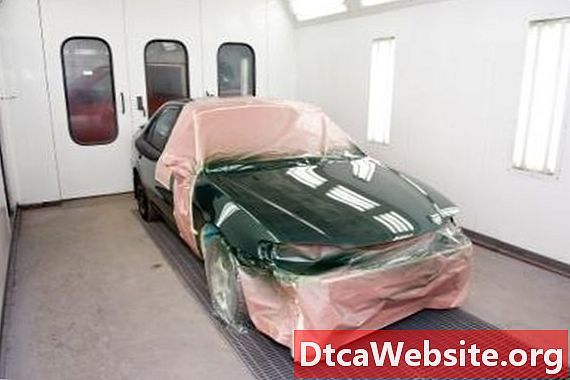
Contenu
- Step 01
- Step 11
- Step 21
- Step 31
- Step 41
- Step 51
- Step 61
- Step 71
- Step 81
- Step 91
- Step 101
- Step 111
- Tips
- Warning
- Items you will need

Bondo Body Filler is used quite often in auto body work. It is a body filler that fills in dents or creases. It is used to sculpt curved areas and areas where welding has taken place, to level the surface flush with the adjoining surface.
Preparing the area before application, mixing the bondo properly, spreading it on evenly and smoothing it out after it is dry are all steps involved.
Step 01
Sand the area to be filled and the surrounding areas with 120 grit paper. This usually works best for removing the surface waxes and paint, with your goal being to have a dull and dry surface for the bondo to stick to. If there is rust in the area, you will need to remove it.
Step 11
Get your mixing pallet, bondo, cream hardener, putty knife and the correct size plastic spreader together. Good idea to have a rag nearby too. Decide on the approximate amount of bondo you will need to fill the area in question, keeping in mind that you will literally only have a few minutes to work with the bondo once mixed, so mix just enough for one area at a time.
Step 21
With your putty knife, take out the amount of bondo you will need from the can and put it on the center of your mixing tray.
Step 31
The small tube of hardener is enough for a quart, so you will only need a small amount of hardener added to the bondo. Squeeze the hardener onto the bondo and use your putty knife to work and mix the hardener throughout the bondo. This should only take a minute or two. Scrape your blade clean on the side of the tray now and then. The premium hairless bondo will be thinner thanthe long hair bondo.
Step 41
Pick up some bondo on the plastic spreader edge and apply it. It may be a little runny at first, so hold your mixing tray level and below the work area to catch any drips. Press it into the dents or creased areas, using smooth long strokes, covering the entire area from side to side or up and down, or both directions -- whichever angle works best to obtain the smoothest finish, preventing any sags from drying by floating the spreader over the area to keep it flat. Once the bondo begins to get stiff and tacky -- within minutes -- stop spreading. Dont worry if it doesnt end up all that smooth, you will remove the excess once it dries hard, but build the height over the dent or crease so that it is flush or higher than the surrounding surfaces. However, if the dent or crease is very deep, you may have to come back later and build slowly with additional applications.
Step 51
Let it dry. This could take some hours, depending on how thick you applied it, how much hardener you used and what the temperature and humidity is. To test if is hard enough, try to dig your fingernail into a corner. If you can make a cut in it, it needs to dry longer.
Step 61
Use the scraper forming tool and scrape down the excess sharp edges or hairs, moving the scraper up and down and side to side, keeping the scraper flush to the surface, until all the hard edges are smoothed down as low as possible. If you used the premium hairless bondo you will probably not need to scrape much, if at all, since it goes on and dries smoother and there will be no hairs to rake down.
Step 71
With your power hand sander, using 60 grit paper, sand over the entire area back and forth and from side to side to get the bondo surface as flush as possible to the surrounding surface and until the bondo edges feathers into the surrounding surface.
Step 81
If you still have rough edges the power sander didnt remove, use the 60 grit on a hand block sander to smooth it out, and then move into the 120 grit paper. Sand down any remaining edges of the bondo and get them as smooth as possible, feathering into the surrounding surfaces. The block sander should be long enough so that when you stroke the work area both ends of the sander also run onto the surrounding surfaces to obtain a smooth, flush, level surface.
Step 91
Using your flat-edge ruler, level or straight stick, check to see if the filled area is truly flush with the surrounding surfaces. Lay the edge across the area at different angels, looking for low or high spots. With the ruler on the car you can mark off with a pencil any areas that need more filler or more sanding.
Step 101
After you have worked your bondo down as smooth as possible, spray prime the entire area, which will allow you to see more clearly if any flaws remain.
Step 111
Hand-block sand with 120 to 220 grit paper and use spot putty glazing compound to fill in any pinholes. Smooth over your feathered edge to create a small amount of height if needed, no greater than 1/16 to 1/8 inch build at a time. If you have deeper pockets you may need to apply more bondo.
Expect a little trial and error since this is like sculpting and is an art, requiring a steady hand. Clean up the mixing tray, putty knife and plastic applicators with some WD-40 or similar oil as soon as possible.
Tips
- Once you start to mix the bondo be ready to move right into spreading it. You will only have a few minutes before the bondo becomes tacky and unworkable.
- You may want to practice or experiment on some other metal or fiberglass before actually applying to the car, so you can get a feel for it.
- To shorten bondo drying time you can place a heat source or halogen light nearby.
Warning
- Always work in a ventilated area.
Items you will need
- 60 and 120 grit sandpaper
- Square or rectangular power sander
- Hand held sanding blocks (palm size and longer)
- Plastic filler spreaders
- Bondo, (long hair, short hair, premium or regular)
- Cream hardener in a tube, usually comes with the bondo
- Pallet or mixing tray, smooth plastic surface
- 2-inch putty knife
- WD-40 for cleaning
- Bondo scraper molding tool (looks like a wood plane with cutting edges)
- Flat edge ruler, level or straight stick
- Glazing spot putty compound
- Auto primer spray


